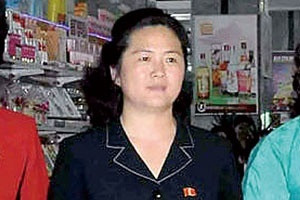Recent expert analysis suggests that Kim Sol-song, the elder half-sister of North Korean leader Kim Jong-un, may be a pivotal figure within the nation’s military apparatus. This assertion casts a new light on the secretive dynamics of North Korean leadership and the individuals operating behind the scenes.
Lee Yun-keol, a research fellow at the Sejong Institute, posits that Kim Sol-song is at the helm of the Supreme Command of the Korean People’s Army’s decision-making body. This organization, believed to have originated under Kim Jong-il’s regime, is crucial for the country’s governance. While Kim Jong-un officially holds the top position, Lee argues that Kim Sol-song effectively manages its operations.
 Kim Sol-song, half-sister of Kim Jong-un, potentially plays a significant role in North Korean military leadership, according to expert analysis.
Kim Sol-song, half-sister of Kim Jong-un, potentially plays a significant role in North Korean military leadership, according to expert analysis.
Born in 1974, Kim Sol-song is the daughter of the late Kim Jong-il and his second wife, Kim Yong-suk. She is distinct from Kim Jong-un, whose mother was Ko Yong-hui. Despite this familial connection to the ruling dynasty, Kim Sol-song’s public profile has remained minimal, contributing to an aura of mystery surrounding her role. Conflicting expert opinions exist, with some suggesting she has been historically excluded from positions of power.
Kim Jong-un ascended to the position of supreme commander of the KPA in December 2011, following his father Kim Jong-il’s death. Lee Yun-keol further speculates that Kim Sol-song could be serving as the chief vice chairperson of the central committee of the ruling Workers’ Party of Korea (WPK), and potentially the first vice chairperson of the State Affairs Commission (SAC). However, these claims remain unconfirmed by North Korean state media, which has not reported on such appointments.
Currently, the WPK’s central committee is chaired by Kim Jong-un and includes nine vice chairmen, while the SAC, established in June of the previous year to replace the National Defense Commission, is also led by Kim Jong-un with three vice chairmen.
Adding to the discourse, Cheong Seong-chang, another senior research fellow at the Sejong Institute, previously highlighted Kim Sol-song’s potential influence on North Korea’s policy-making. He even proposed a controversial theory linking her to the assassination of Kim Jong-nam, Kim Jong-un’s half-brother, in Malaysia. Furthermore, Rep. Ha Tae-keung has publicly suggested that Kim Sol-song herself might be a future assassination target under Kim Jong-un’s directives, underscoring the volatile nature of North Korean power dynamics.
Lee Yun-keol also provided insights into North Korea’s nuclear program, stating that the 216 Institute, operating under the SAC, is responsible for nuclear tests, while a separate think tank under the WPK’s central military committee focuses on nuclear weapon miniaturization and standardization. This division of responsibilities suggests a complex and potentially compartmentalized approach to North Korea’s strategic weapons development under the Kim Jong-un regime.
In conclusion, the role of Kim Sol-song within the North Korean power structure remains largely obscured. Expert analyses, while speculative, suggest she may wield considerable influence, particularly within the military and potentially in policy decisions. As North Korea continues to be a subject of intense international scrutiny, understanding the figures operating within its leadership, including the enigmatic Kim Sol-song, is crucial for informed analysis and strategic foresight.


